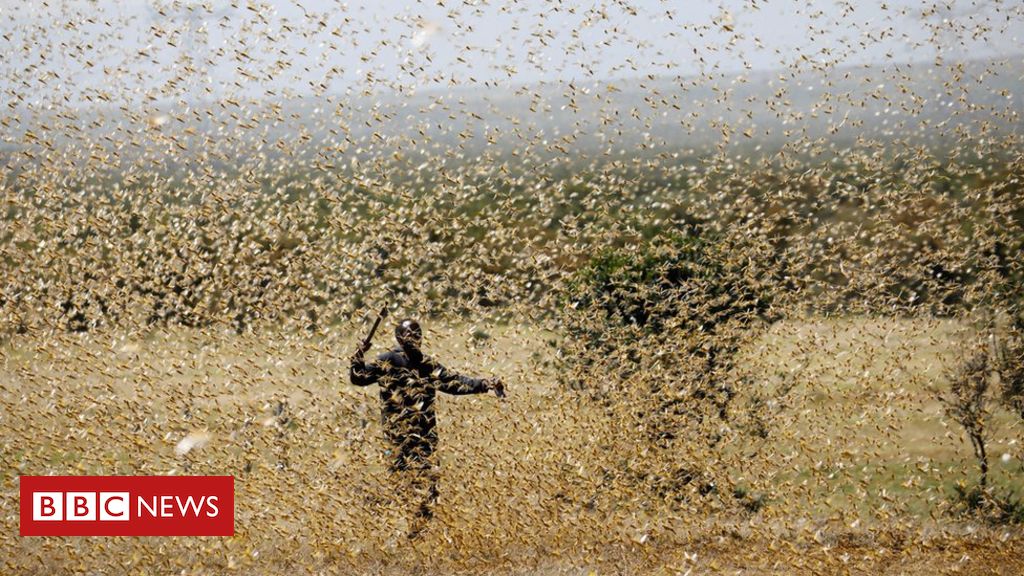Hundreds of billions of locusts are swarming through parts of East Africa and South Asia in the worst infestation for a quarter of a century, threatening crops and livelihoods.
Image copyright
Reuters
A man attempts to fend off a swarm of desert locusts at a ranch near the town of Nanyuki, in Laikipia county, Kenya
Image copyright
Reuters
Men try to repel locusts flying over grazing land in Lemasulani village, Samburu county, Kenya
The insects, which eat their own body weight in food every day, are breeding so fast numbers could grow four hundredfold by June.
Image copyright
Reuters
A swarm of newly hatched desert locusts are seen on a tree as men look on, near the town of Archers Post, Samburu county
In January, the UN appealed for $76m (£59m) to tackle the crisis.
That figure has now risen to $138m.
Image copyright
Reuters
A man walks by locusts in the region of Kyuso, Kenya
But so far, only $52m has been received, $10m of which has come this week from the Bill & Melinda Gates Foundation.
Image copyright
AFP
Uganda Peoples Defence Forces soldiers spray trees with insecticides in Otuke
The main threats are in East Africa and Yemen, as well the Gulf states, Iran, Pakistan and India.
Image copyright
Getty Images
A stalk of sorghum seeds partially eaten by locusts (left) is held next to an undamaged stalk in Nairobi, Kenya
Image copyright
AFP
Swarms feed on shea trees, an important source of food and income for local farmers, in Otuke
Most recently, locusts have been seen in the Democratic Republic of Congo and swarms have arrived in Kuwait, Bahrain and Qatar and along the coast of Iran.
Image copyright
Getty Images
A UPDF soldier prepares pesticide equipment in Katakwi
Image copyright
AFP
A UPDF soldier sprays plants with insecticides in Otuke
Aerial and ground spraying combined with constant tracking of the swarms are viewed as the most effective strategies.
But Desert Locust Control Organization for Eastern Africa head Stephen Njoka told BBC News aircraft were in short supply.
Currently, Ethiopia was using five and Kenya six for spraying and four for surveying, he said.
Image copyright
AFP
A woman holds a plastic bottle filled with locusts in Lopei, Uganda
But the Kenyan government says it needs 20 planes for spraying – and a continuous supply of the pesticide Fenitrothion.
Image copyright
AFP
A UPDF soldier holds a locust in Otuke
Image copyright
Getty Images
A desert locust is held in Katakwi
Kenya has trained more than 240 personnel from affected counties in monitoring of locust swarms.
Image copyright
EPA
A man runs through a desert locust swarm in the bush near Enziu, Kitui county, about 200km (124 miles) east of the capital, Nairobi
The Chinese government announced in February it was sending a team of experts to neighbouring Pakistan to develop “targeted programmes” against the locusts.
According to reports, they could deploy 100,000 ducks.
Image copyright
AFP
Locusts swarm across a highway at Lerata village, near Archers Post, about 300km north of Nairobi
Image copyright
EPA
A local tour guide holds a handful of dead desert locusts in Shaba National Reserve in Isiolo, northern Kenya
Lu Lizhi, a senior researcher with the Zhejiang Academy of Agricultural Sciences, told Bloomberg the ducks were “biological weapons”.
And while chickens could eat about 70 locusts in one day, a duck could devour more than three times that number.
“Ducks like to stay in a group, so they are easier to manage than chickens,” he told Chinese media.
Image copyright
EPA
A desert locust swarm flies over a bush in Ololokwe, Samburu county
Source: CNN Africa
